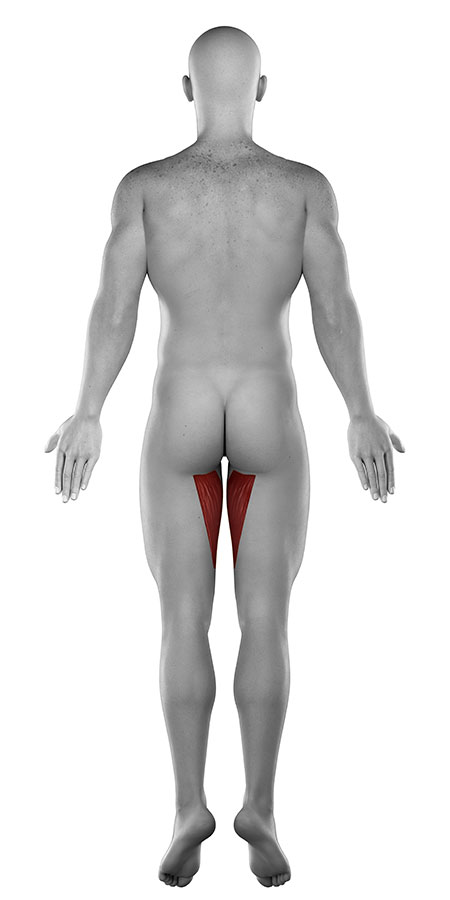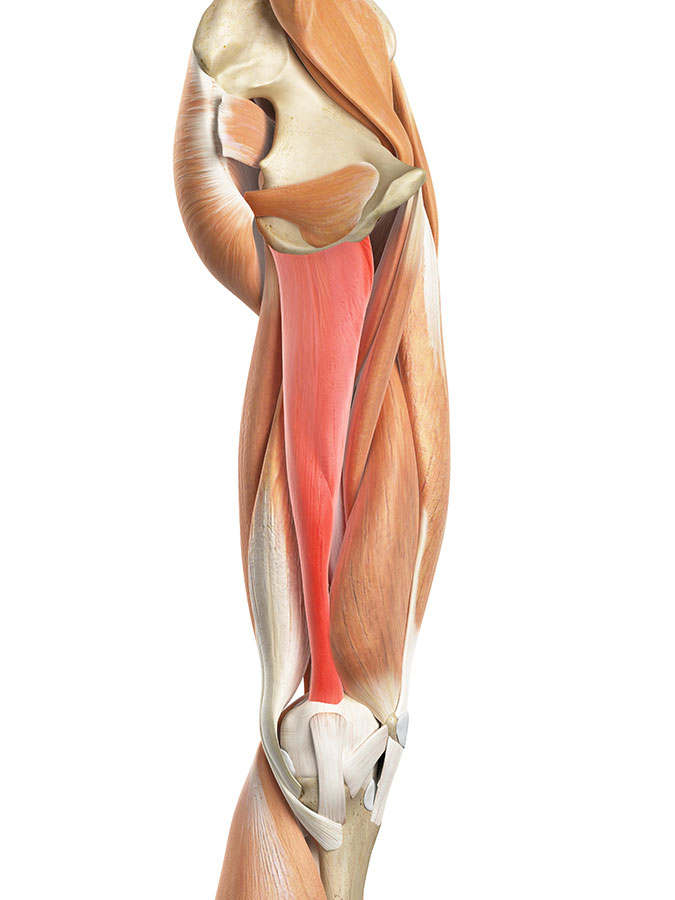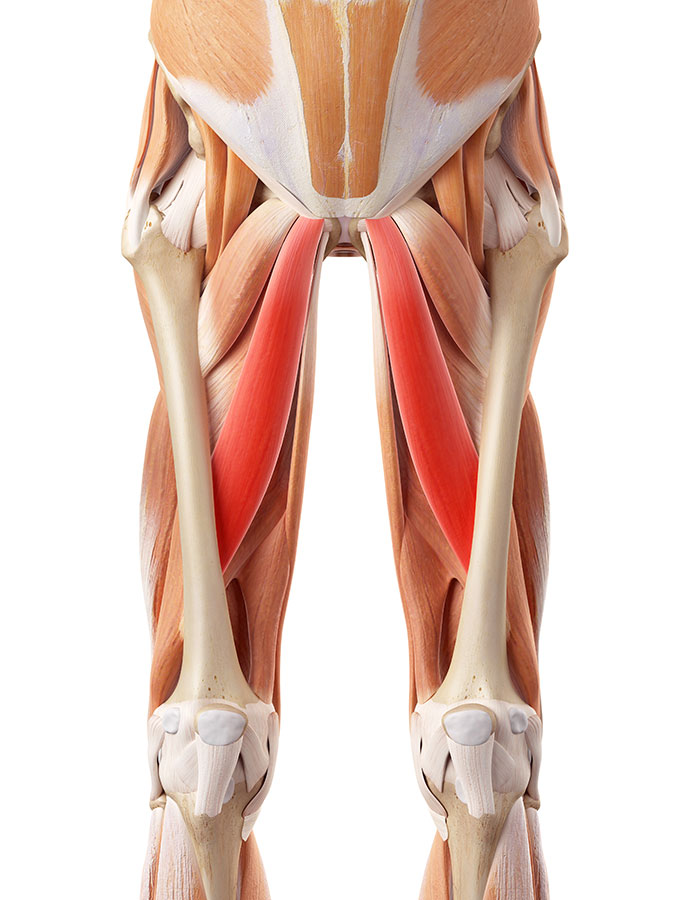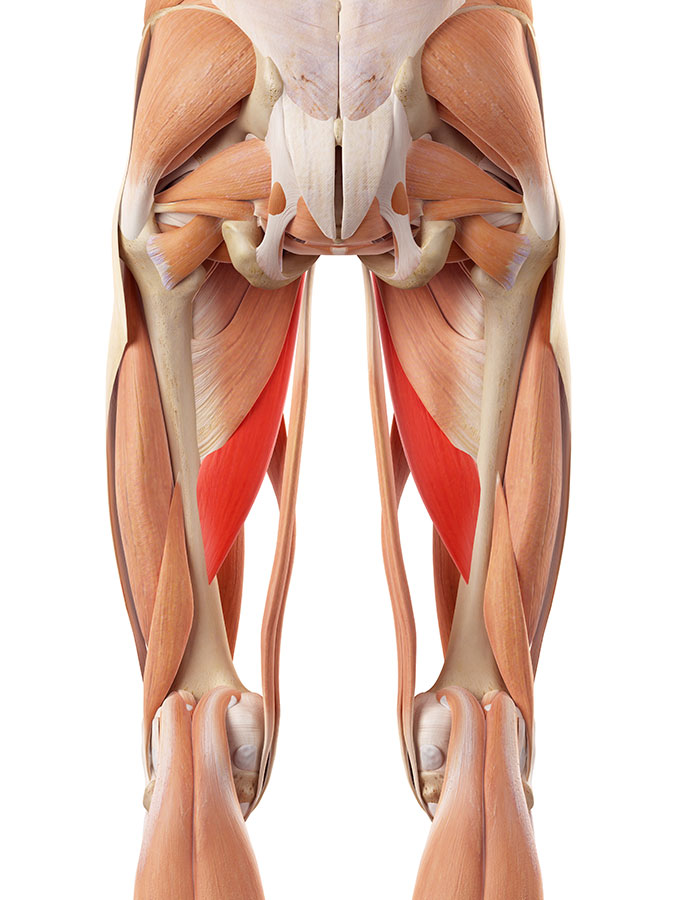A groin strain refers to when any of the five adductor muscles on the inner thighs are overstretching or tearing (rupturing). Ever jumped into a split or slid sideways into a stretch on slippery tiles? Well, then you’ve felt the muscles in your groin keeping you up. In most cases groin strains are minor tears of a few fibers with the bulk of the muscle remaining intact, while the anchor sites of the muscle tend to be more vulnerable. Groin strains can affect any of the five hip adductor muscles. Your adductor muscle group pulls your leg upwards and inwards (towards the center of your body) while walking, running, or balancing on one leg.
Groin muscle strains are fairly common, with a rate of 1.2-7% of injuries with a high recurrence rate of 60%. This means that it’s under-diagnosed and is very likely to be injured again. Take that into consideration when you think it’s getting better… The risk of it getting worse is 60%. Rather ask our experts to guide you.
These muscles are essential for keeping your pelvis and hip stable. Let’s have a look at the different signs & symptoms you’ll feel if you suspect you’ve torn a groin muscle.
What does the groin muscles do?
There are five hip adductor muscles. The “big guys” of the adductor group is the adductor brevis, adductor longus and adductor magnus muscles (the short, long and massive adductor brothers). The two smaller adductors are the gracillis and pectineus muscles. Although these muscles are quite small, they play a vital role in stabilizing your hip. When all five of these muscles contract they pull the thigh bones (femurs) together, like when you really need the bathroom.
Your groin muscles anchor onto a small area on your pelvis (pubic symphysis) and insert on the inside of your thigh bone (femur). They run along the inside of your inner thigh and pain tends to get worse along the inside of your thigh, then upwards towards your groin. The joints involved, which may contribute or suffer under a groin muscle strain, are your hip, SI (sacroiliac) joint and your pubic bone.
Each person’s case is unique and we want to address your specific needs. If you would like us to investigate or provide some insight, we invite you to contact us by clicking the link below.
How does a groin muscle strain happen?
Groin strains are caused by strenuous stretching movements of the legs when sprinting, kicking a ball or a sudden change in direction. Overuse & overload in a stretch of the adductor muscles lead to tears. This is most frequently seen in sports like hockey, tennis and rugby. Adductor muscle strains are common among dancers too, because of over stretching.
Ever slipped on a wet floor? As your leg slides outward, your groin muscles contract to keep your legs together. This “split” movement under all your body’s weight causes a contraction from a stretched position – this fast-sudden contraction while you slip can pull your groin muscles to the point of tearing. If you’ve jumped into a split (not to mention the tearing of your jeans) the pull on your groin muscles are just as great.
An adductor strain disturbs the synchronization between muscles on the inside and outside of your hip that leads to a variety of problems in and around your groin. The inner and outer muscles must control and distribute weight to your legs. When this harmony is disrupted, the outside group has to work a lot harder to compensate.
Causes of groin muscle strain
- Overload – the muscle or tendon cannot withstand the load placed on them, which causes small (tears strains) i.e. Side lunges & sideways squats
- Overuse – repetitive overload, rest, overload leads to tendon inflammation and ultimately muscle strains.
- Overstretch – Stretching the legs into a middle split too often i.e. Hitch-kicks, Split jumps, Chete jumps & off axis side splits.
- Poor management of osteitis pubis (A condition where forces around the pelvis causes bone pain and tendon inflammation)
- Instability – muscle imbalances around the hip joint. i.e. Trail runners, marathon athletes and endurance riding.
- Referral – groin pain may come from your lower back, urinary or digestive systems.
- Trauma – contusions or femur stress fractures. i.e. fall, slip or slide with your legs separating
- Autoimmune – Rheumatoid arthritis.
- Referral from nerves – irritation, compression of the sciatic or femoral nerve branches.

Self test
How bad is my groin muscle strain?
All strains are graded from 1 – 3. Grade 3 groin strain is a complete tear or rupture of 80% of the muscle fibers, grade 1 groin strain is a tear of between 15-30% of muscle fibers, with grade 2 everything in between. This leaves a big grey area. Also remember that the adductor muscle group consists of 5 muscle, any one or all of them may be injured to a greater or lesser degree. Things can be complicated, that is why it is best to get expert advice.
If your groin strain treatment is delayed, you’ll develop more pain radiating down your inner thigh, which leads to spill over to other structures in and around your hip. Groin tendinitis (Tendon pain from the anchors on the bone), osteitis pubis (Traction injury of the membrane covering the pubic bone) and even stress fractures of the pubic and femur.
Diagnosis
Our physiotherapist will diagnose the condition from your medical history and the results from the physical examination. An ultrasound (diagnostic sonar) is very helpful to visualize the severity and size of the tear. We will do all the necessary tests to pinpoint which of the five adductor muscles are strained, but most importantly, we’ll test all the surrounding structures to ensure there’s no other structures that may be involved. Stress & stretch tests are best to differentiate between the groin muscles.
MRI and CT scans aren’t necessary to detect a pulled groin muscle, but may exclude structures inside your hip joint like labrum tears. X-rays show the bone edges and how your hip socket connects to your femur head. After a fall, X-rays will be taken to rule out fractures. Even if nothing abnormal is found on an X ray and you are still experiencing pain, do not despair, a lot of structures are not visualized on X-rays. Get our expert’s advice to help you understand where your pain is coming from.
Why is my groin pain not going away?
Groin muscle strains are generally caused by some instability in the kinetic (movement) chain. It may be weakness of the hip or pelvic stabiliser muscles. If your groin injury is only treated locally, in the groin area itself, these contributing factors may be missed and neglected. Your pain gets better, your movement improves and you get back to participating in your sport of choice. If instability caused the problem in the first place and was not addressed, it is no wonder that in a month or two your pain “comes back”. When the whole chain of movement is not considered and evaluated, the contributing factors cannot be addressed. Your groin injury may only be a victim, with the true culprit being another structure all together.
We need to assess the movement and stability of the lower back, hips, knees and even feet, to get an idea of what happens to your groin on the playing field or stage.
Wishful thinking, “the problem will go away by itself” has never helped anybody. Rest will definitely make you feel better. But the same weakness or instability that led to the problem in the first place won’t just disappear. You need to address the whole of you to get to the bottom of your unique problem, get it treated and prevent recurrence in the future. We can help you.
Heat increases blood flow to the area and, therefore, prolong muscle bleeding which causes increased pain and swelling in your groin. Avoid soaking in hot baths & warm-water bottles in the first week of an adductor muscle strain.
A big problem we see with groin muscle strains
Many of the groin injuries we see are chronic (lasts longer than three months). It can take up to 20 weeks for a groin muscle strain to heal and become pain free, so most people continue to train through the pain. This result is a muscle that is constantly flared as soon as any stressor is increased e.g. training load or volume. The first incident is the most important, as correct treatment will change the outcome in the long run considerably.
“Tightness” is a subjective feeling of restriction. A healthy muscle won’t ever just feel tight for the sake of feeling tight. It is normal to feel stiff after heavy training or doing something that you are not used to, or with injury. Mindlessly stretching to increase length or “relax” the muscle, may very well have the exact opposite effect. Muscles are “passive aggressive”. They may follow this logic: “If I’m tight because of an injury and you stretch me, guess what? I’ll feel worse! Just to get back at you. So, I’ll contract some more.” Only one way to stop this cycle.
A thigh brace is great for compression and reducing an acute injury’s swelling. You won’t use crutches longer than you absolutely have to, so why wear a thigh brace for longer than you need to? We’ll help you understand when it’s needed and when it is becoming a crutch.
Groin muscle strain physiotherapy treatment
Physiotherapists will accurately diagnose a groin muscle strain, and other injured structures, without expensive scans. We know and understand the anatomy of the hip and pelvis, and we know which structures could be injured with a pulled groin muscle. We take into account the intricacy of the biomechanics of your hip.
You should schedule an assessment with our physiotherapist as soon as possible after your injury, so we can determine how bad your groin strain is by loading and stressing each one. This gives us a clear picture of how many of the adductor muscles are injured and how long recovery might take.
We will also look at other structures in and around your hip and pelvis that could have been injured too. We can reach a conclusive diagnosis by also testing muscle strength and length, range of movement and by measuring swelling in the area. This is why our physiotherapists are the best at treating a groin strain.
Your physiotherapist will use a number of treatment techniques to reduce your pain and swelling, and accelerate the healing of the damaged structures. These techniques include:
- Acute injury treatment
- Ultrasound
- Medications
- Soft tissue massage
- Laser (Low Level Laser therapy)
- Crutches
- Acupuncture & Dry Needling
- Kinesiology Tape
- Rigid Strapping or taping
- Neurodynamics (Nerve tissue mobilizations)
- Dynamic Strapping
- Myofascial release
- Strengthening exercises
- Guided loading protocol
- Stretches (Static, dynamic and ballistic)
- Compression bandage or sleeve
Phases of physiotherapy treatment for groin muscle strains
Acute phase treatment
Your physiotherapist will use manual therapy and soft tissue therapy to help reduce the muscle pain and we suggest you use crutches to take the weight of your groin muscles. We will assess the strength of your adductor muscle group along with a full biomechanical assessment of your hip and knee, to determine other influences along the chain.
You may begin:
- Intensity isometric adductor squeezes.
- Deep water pool running as the pain allows.
- Low-level core stability exercises such as a single arm and leg raise.
During this phase of your treatment the aim is to reduce the load placed on the adductor muscles by limiting movement or using crutches. “Aggressive rest” decreases healing time. Ultrasound and LASER therapy decreases pain while increasing circulation to the area. Increased circulation aids healing.
Intermediate phase treatment
During this phase of treatment the aim is to restore full movement. We do this by releasing unnecessary tissue restrictions (this is protective during the acute phase, but unnecessary now) with means of deep dry needling and myofascial release. Active exercise, joint mobilisations and nerve glides can be added to your treatment to allow and coax the hip and adductor muscles into movement in a safe way that has no threat value.
Strengthening program
- Ball squeezes (legs bent to legs straight)
- Concentric adduction with weight against gravity
- Side-bridge (both sides, start double leg then single leg)
- Adduction in standing on cable column or elastic resistance
- Seated adduction machine
- Standing with involved foot on sliding board moving front to back (walking)
- Both hips adducting on sliding board moving sideways
- Lunges with reciprocal arm movements
You should be able to perform isometric adductor squeezes with minimal pain.
Your physiotherapist will assess the function of your adductor group in comparison with a non affected side, you should feel minimal discomfort.
You may begin:
- Squat and single leg squats. Stop if you feel pain.
- Functional warm-up drills such as walking lunges and full-body exercises. You should not feel any pain.
- Upper limb strength training. Do not exert pressure on your injured adductor.
- Box step ups
- Adductor pulley exercises (no pain)
- Moderately level of core stability training such as side planks.
Final phase
During this phase the aim is to get you back to participation. Treatment will be more focussed on exercises to establish good control, strength, endurance, balance, proprioception and plyometrics.
Sportspecific training
- Kneeling adductor pull together
- Elevated side-bridge
- Ball Squeeze bridges
- Adductor resistance band kicks
- Standing resisted stride lengths on cable column
- Slide skating
- Cable column crossover pulls
Clinical goal
Adduction strength at least 80% of the abduction strength.

How long will it take for my groin muscle strain to heal?
Most uncomplicated groin strains take approximately 4 – 6 weeks to heal, depending on the severity of your injury. However you may not regain full fitness for another 2 weeks. Depending on the severity of the injury it may cause longer term effects. When a significant groin strain occurs, a number of other structures in the groin may also be injured. Injury to these structures can delay recovery. Recovery can also be delayed if the injury is not managed correctly. Incorrect management can cause tight, weak muscles in the groin that are more likely to be re-injured in the future.
The adductor group plays a vital role in hip stability, this is why it is of utmost importance to restore normal movement around the hip joint. This is why the rehabilitation process take so long. Patience is key.
Most common groin injuries we treat:
- Groin strains (adductor strains) and adductor tendinopathies (tendon inflammation)
- Osteitis Pubis
- Inguinal hernia
- Groin pain & injury
- Inner thigh pain
- Sportsman’s groin
Over half of people with groin muscle strains have pain for up to 20 weeks
We can make that significantly less
Other medical treatments for groin strains
Medication (anti inflammatories and analgesics) can be prescribed by your GP. Responsible use of medication can minimise pain so that you can get your rehab done. Medication will not cure the problem, just mask (to manage) the symptoms.
Biokinetics can aid us in conditioning training once you have regained full range and have minimal pain.
Surgery is rarely considered. If you sustain an avulsion fracture, where the bone is pulled away because of the severity of the muscle injury, it may be considered. Rehabilitation takes longer to complete.
Surgery for groin injuries
Depending on the injured structures, cause and contributing factors, a number of different surgical options may be considered.
An inguinal neurectomy can be performed if the femoral nerve is involved.
If you have a hernia repair, it may be done with or without mesh. This procedure requires 3 months of recovery as your abdominal pressure (think lifting, exercise and even bowel movements) influences the wound.
An adductor tenotomy is performed when the adductor attachment at the pubs is cut to increase length and greater range of motion.
Can a groin muscle injury be prevented?
Prevention is better than cure, we believe so strongly in this principle that it forms part of our logo. An adductor strain injury prevention program can assist in decreasing the risk of the injury occurring. (Tyler et al. (2010) Sports Health 2(3): 332-348)
- Warm-up Bike
- Adductor stretching
- Sumo squats
- Side lunges
Groin strain also known as:
- Groin disruption
- Pubis symphysis instability
- Sportsman’s groin
- Athletic pubalgia
- Gilmore’s groin
- Adductor tendonitis
- Osteitis pubis
- Sportsman’s hernia
- Pulled groin muscle
- Adductor muscle strain
What else could the groin pain be?
- Referral from the lower back
Pain will be dull and achey and related to back position (sitting etc.), hip movement won’t change symptoms.
- Irritation or compression of the sciatic or femoral nerve
Pain will have a more “nervy” quality, numbness or pins and needles.
Constant pain, worse with weight bearing.
- Inguinal hernia
Symptoms are worse with higher intra abdominal pressure, like coughing, sneezing or bloating.



